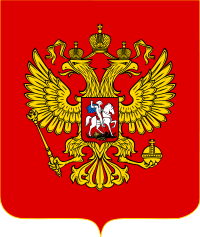Coat of arms of Russia
| The coat of arms of the Russian Federation | |
|---|---|
 |
|
| Information | |
| Date of origin | 30 November 1993 |
| Shield | Gules a two-headed eagle each head imperially crowned holding in his dexter talon a sceptre and in his sinister talon a globus cruciger ensigned by an imperial crown all Or an inescutcheon displayed upon the breast gules a representation of a knight upon horseback slaying a dragon all Or. |
The coat of arms of the Russian Federation derives from the earlier arms of the Russian Empire, as restored in 1993 after constitutional crisis. Though modified more than once since the reign of Ivan III (1462 - 1505), the current coat of arms is directly derived its mediaeval original. The general chromatic layout corresponds to the early fifteenth century standard . The shape of the eagle can be traced back to the reign of Peter the Great (1682 - 1725), although the eagle in the modern arms is gold instead of the imperial black.
The two main elements of Russian state symbols (the two-headed eagle and the mounted figure slaying a serpent or dragon) predate Peter the Great. The Great State Seal of Ivan III, grand duke of Moscow, featured a horseman slaying (or struggling with) a dragon. The figure was not officially identified as Saint George until 1730, when it was described as such in an Imperial decree. The older form (a mounted dragonslayer known as "Победоносец", "Saint George the Victory bearer") was always associated with the Grand Duchy of Muscovy, later becoming the official arms of the city of Moscow. The earliest graphic representation of a rider with a spear, in 1390, is in a seal of the prince of Moscow, Vasiliy Dmitriyevich. The serpent or dragon was added under Ivan III. Saint George henceforth became the patron of Moscow (and, by extension, of Russia).
Today, the official description does not refer to the rider on the central shield as representing Saint George, mainly in order to maintain the secular character of the modern Russian state.
The double-headed eagle was adopted by Ivan III after his marriage with the Byzantine princess Sophia Paleologue on 12 November 1472, whose uncle Constantine was the last Byzantine Emperor. The double-headed eagle was the official state symbol of the late Byzantine Empire, spanning both East and West. It, amongst other aspects, symbolized the unity of Church and State. After the Fall of Constantinople to the Anatolian Turks in 1453, Ivan III and his heirs considered Moscovy (Moscow) to be the last stronghold of the true, orthodox, Christian faith, and in effect, the last Roman Empire (hence the expression "Third Rome" for Moscow and for the whole of imperial Russia). From 1497, the double-headed eagle proclaimed a Russian sovereignty equal to that of the Holy Roman Empire, whose rulers likewise claimed to be the inheritors of the Christian Roman tradition. The earliest known evidence of the double-headed eagle as an official emblem of Russia is on the great prince's seal, stamped in 1497 on a Charter of share and allotment of independent princes' possessions. About the same time, the image of a gilt, double-headed eagle on a red background appeared on the walls of the Palace of Facets in the Moscow Kremlin.

The arms were modified during the reign of the Romanov dynasty, Mikhail Feodorovich: the double-headed eagle was adorned with three crowns for the first time in 1625. Through time, these crowns have been interpreted variously as representative of the conquered kingdoms of Kazan, Astrakhan, and Siberia, or as representing the unity of "All the Russias" (Great Russia, the present-day Russian Federation; Little Russia, now the Ukraine; and White Russia, now Belarus).
The current coat of arms was designed by artist Yevgeny Ukhnalyov; it was adopted officially on November 30, 1993 [1]. Today, the imperial crowns stand for the unity and sovereignty of Russia both as a whole and in its constituent republics and regions. The orb and sceptre are traditional heraldic symbols of sovereign power and authority. They have been retained in the modern Russian arms despite the fact that the Russian Federation is not a monarchy, which led to objections by the Communists even though both the blue ribbon and the collar of the Order of St. Andrew (which in the imperial arms supported the three crowns and surrounded the central shield) have been removed from the current coat of arms.
The modern arms of Russia were instated by a presidential decree in 1993, and then by a Federal Law signed by President Vladimir Putin on December 20, 2000.
Contents |
Gallery
 Coat of arms of Russia before May 16, 1992 |
.svg.png) Coat of arms of the Russian Federation May 16, 1992—November 30, 1993 |
 Coat of arms of the Russian Federation after 1993 |
Coat of arms of Russia, photographed at the Consulate-General of Russia in Houston |
 Five double-headed Russian coat-of-arms eagles (below) substituting the former state emblem of the Soviet Union and the “CCCP” letters (above) in the facade of the Grand Kremlin Palace |
Trivia
- The coat of arms is a fractal - the top of the sceptre held by the eagle contains another, much smaller copy of the whole coat of arms.
- The double eagle is colloquially known as Chernobyl Chicken.
See also
- National emblems of the Russian Empire
- Coat of arms of the Russian SFSR
- Coat of arms of Moscow
- Flag of Russia
External links
- (Russian) Federal Constitutional Law about the State Coat of Arms of Russian Federation
- (Russian) Official Coat of Arms Rendition in GIF format
- (Russian) The history of the Coat of Arms of Russia
|
|||||||||||||||||||||||||||||
|
|||||||||||
|
||||||||||||||
|
|||||||||||||||||
